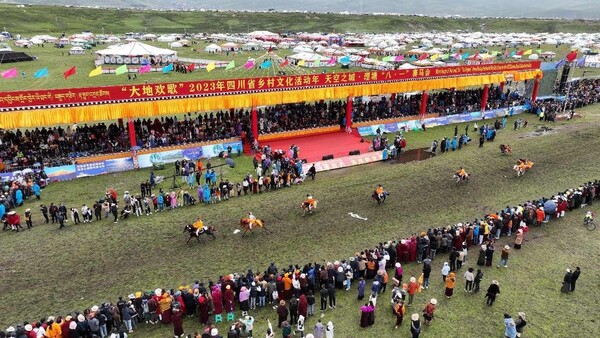By Li Kaixuan, People’s Daily
Litang county is located in the southwestern part of the Garze Tibetan autonomous prefecture, southwest China’s Sichuan province. Situated on a plateau with an average elevation of over 4,000 meters, it is known as the “City in the Sky.” With snow-capped mountains and picturesque grasslands, the scenery there is breathtaking.
Thanks to the internet and the growing popularity of cultural tourism, Litang has become a popular destination in recent years, attracting more and more visitors. In 2023, the county received 3.19 million tourists and generated a total tourism revenue of 3.92 billion yuan ($545 million), representing a year-on-year growth of 66.7 percent.
The Genyen scenic area, which features a 6,204-meter snow-covered peak that always shines brightly under the sunlight, is to the southwest of Litang county across a grassland.
“There are hot springs here,” said a tourist surnamed Chen, seeing the gentle flow of a stream in Rangrikar village at the foot of the Genyen Mountain. He took off his shoes and stepped into the water.
Chen had driven all the way from Shenzhen, south China’s Guangdong province, and had already stayed in Litang for half a month. There were quite a few tourists living in the village, and Chen said that leaving behind the hustle and bustle of the city and immersing himself in the nature allowed his soul to rest.
Letong ancient town, a folk culture scenic area, was established in Litang in 2018, with a total investment of nearly 80 million yuan. Tourists can explore ancient landmarks, enjoy traditional opera performances, and wander through mini museums in the town, where around 4,000 local households live.
Horse racing has a long history in Litang, where a grand horse racing festival is held annually in the sixth month of the Tibetan calendar. This event has been hosted for over 400 years and gradually evolved into the Litang Horse Racing Festival that falls on Aug. 1 each year.
During the festival, people dress up in their finest attire, prepare delicious food and drinks, and gather on the grassland to enjoy equestrian performances.
However, as the times have changed, the younger generation has been embraced by more and more modern cultural activities, resulting in a decline in the number of horse racing enthusiasts and inheritors of equestrian performances.
In response to this, the Litang Horse Racing Festival encourages tourists to engage in horse riding activities, stages song and dance performances, and holds food exhibitions. In addition, it has collaborated with small-scale horse racing events in towns and villages to build unique tourism routes, further promoting the development of the horse breeding and racing industry.
After setting up his phone, Dawa, who was born in the 2000s, started livestreaming and introduced the essentials of horse riding.
Dawa returned to his hometown and became a streamer after graduating from university in 2023. Now he has around 40,000 followers on short video platforms. In Litang, almost every village has such young individuals.
To preserve culture and make it bloom, remote small towns have to actively innovate amidst the collision of diverse cultures. Young people in Litang have brought traditional skills such as equestrianism, traditional opera, and textile craftsmanship to online spaces. From natural landscapes to folk customs, Litang maintains a high level of popularity on short video platforms throughout the year. The popularity of short video has been on the rise, which has opened a new cultural window for Litang, nurturing over 30 online streamers each with more than 10,000 followers.
After a video featuring Tenzing Tsondu, a young man from Litang, went viral on the internet in November 2020, a short video showcasing charm of Litang received over 700 million views within 72 hours of its release, and the online search volume for “Litang” surged by 620 percent.
The online popularity translated into a boost for tourism. During China’s National Day holiday in 2021, tourism revenue of Litang increased by 72.4 percent year on year. Throughout the year, the county received more than 1.6 million tourists, generating tourism revenue of 3.98 billion yuan.
According to Gerong, director of the Litang tourism bureau, the comprehensive tourism revenue of Litang accounted for 26 percent of the county’s GDP in 2022.
“To achieve long-lasting success, we need to take solid steps,” said Gerong. The cultural and tourism industry has a wide range of implications, and the county has organized various departments to discuss the development path in depth.
Services have become more professional. The number of hotels in the county continues to increase and has exceeded 450. Local training programs have been implemented to enhance the skills of employees, and a cultural and tourism “think tank” has been established. The number of B&B hotels in the county has exceeded 100.
Supporting facilities have been improved. Approximately 300 million yuan has been invested in tourism infrastructure construction, aiming to transform Litang into a provincial-level comprehensive tourism demonstration zone. In 2022, a cultural and tourism big data center was established to digitize and consolidate tourism resources, making the county smarter.
The rise of internet-famous cities is a manifestation of the vitality of cultural economy. Yan Lijiao, vice dean of the Zhejiang University Tourism and Leisure Institute, believes that the long-lasting popularity of these cities relies on continuous innovation.
By adopting a holistic approach to the entire industrial chain, cities can create unique features in various aspects such as food, accommodation, transportation, shopping, and entertainment, she said, adding that by focusing on their strengths and expanding their advantages, these cities can showcase a variety of highlights that attract visitors.
Today, unique products like yak milk and butter are transformed into creative cosmetics, while new activities such as trip shooting in ancient towns, horse riding tours, and stargazing camping gain popularity. In Litang, the cultural and tourism industrial chain continues to extend, generating new momentum for development.












